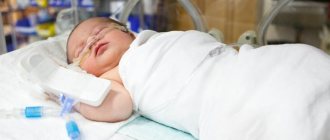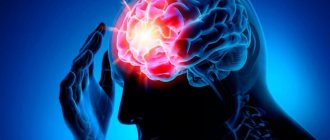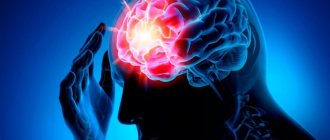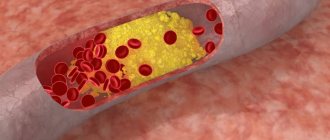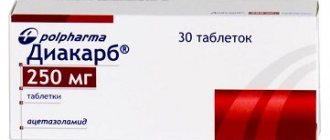The diagnosis of “perinatal damage to the central nervous system” unites a large group of lesions of the brain and spinal cord, different in cause and origin, that occur during pregnancy, childbirth and in the first days of the baby’s life. From 5 to 55% of children in the first year of life receive this diagnosis, since this number sometimes includes children with mild transient disorders of the nervous system. Severe forms of perinatal CNS lesions are observed in 1.5–10% of full-term and 60–70% of premature infants. Severe perinatal brain damage (including intracranial hemorrhage, severe cerebral ischemia) pose a real threat to the life and health of the child, even with timely, highly qualified medical care in a perinatal center. Moderate and mild forms of brain damage do not pose an immediate threat to life, but they can cause mental disorders and the development of motor activity in a child.
Modern views
Perinatal damage to the central nervous system is a complex of organic and/or functional damage to the central nervous system of the fetus in the prenatal period from the 26th week or of the newborn to 7 days, which manifests itself in the first hours, days, months of the child’s life.
Damage to the central nervous system in a child is the main cause of the development of movement disorders, hypertensive-hydrocephalic syndrome, hyperexcitability or depression syndrome, as well as the syndrome of vegetative-visceral disorders.
The diagnosis of PPCNSL in a child is usually made in the maternity hospital and requires correction.
This diagnosis of PPCNSL in children is applicable up to the age of 1 year. Damage to the central nervous system in newborns is a reason to establish the cause, diagnostic tactics and treatment of this problem. Underestimation of the state of PCPNS in a newborn can provoke the development of neuropsychic, motor and visceral disorders.
Severe cerebrovascular accidents, trauma, ischemia or intracranial hemorrhage can pose a great threat to the child's life.
Syndrome of increased neuro-reflex excitability
Increased neuro-reflex arousal in a newborn is characterized by a pronounced reaction to various types of irritation: the baby becomes anxious, trembles, cries and screams in response to any touches and sounds. In addition, the baby has an increase in muscle tone, he often begins to throw his head back. If the central nervous system is damaged, it is practically impossible to calm the child.
Newborns with NWS sleep very little and are very difficult to feed. Most often, such children additionally experience convulsive syndrome. For diagnosis, doctors use a certain classification of seizures.
It must be remembered that only a doctor can make the correct diagnosis. When diagnosing, he pays attention to muscle tone, as well as the child’s reflexes. Second, the doctor checks the child's intracranial pressure. It is important to examine the child’s behavior for appropriateness to age and development.
After diagnosing SPNRS, the specialist prescribes medications to improve cerebral circulation, sedatives and prescribes massage. If increased intracranial pressure is detected, additional diuretics may be prescribed.
You should not think that this symptom will go away as the baby grows and develops. Parents need to constantly monitor intracranial pressure, which in the future will help avoid such serious disorders as headaches and vegetative-vascular dystonia.
The most effective treatment for NSAIDs is movement. However, this method of treatment requires a lot of effort from parents: massage and gymnastics, as well as other procedures, must be carried out daily. At the same time, the child’s brain begins to receive the correct information and recovers faster.
Reasons for development
Perinatal damage to the central nervous system may have a number of main reasons for its development:
Diseases of the mother with symptoms of chronic or acute intoxication;
Acute inflammatory or infectious diseases, as well as exacerbation of chronic foci of infection during pregnancy;
Nutritional (nutritional) disorders of the mother during pregnancy, insufficient or irrational nutrition;
Hereditary diseases of the mother associated with disorders of blood flow, blood vessels, autoimmune diseases;
Metabolic diseases;
Young or old age of the pregnant woman (under 18 or over 35 years);
Severe pregnancy with symptoms of toxicosis, threat of miscarriage or bleeding in the anamnesis, poisoning with poisons, metals, as well as disruption of utero-fetal-placental blood flow, preeclampsia or eclampsia, polyhydramnios;
Labor disruption: rapid or prolonged labor. Childbirth with a large fetus, multiple pregnancy, weakness of labor, clinically or anatomically narrow pelvis;
Immaturity and/or prematurity of the fetus;
Congenital malformations of newborn systems;
Damage to the central nervous system in a newborn can have causes such as intoxication, infections, poisoning, and most importantly, developmental defects and hereditary predisposition. Damage to the central nervous system in a child may be a consequence of trauma during pregnancy or childbirth. A long anhydrous interval, discoordinated labor, cesarean section, entanglement of the fetus with the umbilical cord are also causes of the condition - perinatal damage to the central nervous system.
The consequences of this syndrome can be expressed during the neonatal period, infancy and in older children.
Causes of central nervous system damage in newborns
Suppression of the central nervous system of a newborn during and after childbirth can occur for three main groups of reasons: ischemic-hypoxic lesions, traumatic and infectious-toxic. Let's look at each group in more detail.
- Ischemic and hypoxic lesions of the central nervous system in newborns
are caused by a lack of oxygen in the child’s blood during childbirth. This may be due to long and protracted labor, weakness of labor, abnormalities of the placenta and umbilical cord. With ischemia (complete absence of oxygen), brain cells die, and the further picture of the disease depends on which part of the cortex this happens. - Traumatic lesions of the central nervous system
- in the vast majority of cases occur during childbirth. The immediate cause may be an early birth (the baby’s head is born very quickly and is injured), a large fetus, unskilled actions of the obstetrician, etc. - Infectious and toxic lesions
can be associated with viral infection, alcohol, smoking during pregnancy, etc.
Brain lesions most often have an ischemic-hypoxic nature, while the spinal cord is more often affected by physical trauma to the child’s neck during childbirth. To prevent this, it is very important to give birth in a good maternity hospital with a competent obstetrician, and in the first days after discharge, go to see an osteopath.
Prognosis and outcomes
The diagnosis of central nervous system damage or the diagnosis of PPCNSL in a child occurs in 85% of newborns.
Motor disorders may occur, for example, motor excitability or depression syndrome, which significantly aggravates the child’s condition and disrupts his further adaptation in society.
Damage to the central nervous system in a newborn can cause the development of hyperexcitability in a child with a disorder of attention, memory and development of basic skills - speech, writing and reading.
Damage to the central nervous system in a child can have different outcomes:
complete recovery, mental retardation, minimal brain dysfunction, nervousness, epilepsy, hydrocephalus, cerebral palsy, vegetative-visceral disorder syndrome.
In older children, a child's adaptation disorder, memory and attention disorders, high distractibility and mental fatigue develop.
PPCNSL in newborns can cause the development of dysfunction of the gastrointestinal tract and cardiovascular system.
Osteopathic treatments
Osteopathic treatment of central nervous system lesions in newborns is aimed at eliminating anatomical dysfunctions in the newborn’s body, restoring normal biomechanical relationships of all bones and joints, as well as soft tissues damaged during traumatic birth. Examples of techniques that are included in the osteopathic course of treatment for newborns:
- Fascial decompression of the sacrum, sacrolumbar joints.
- Removal of blocks at the level of the articulation of the first cervical vertebra and the skull.
- Balancing the tone of the thoracoabdominal diaphragm.
- Release (normalization of muscle tone) of the upper aperture of the chest, collarbones, shoulder blades, first rib.
- Decompression of sphenobasilar synchondrosis.
- Balancing the mutual tension membranes of the cranial cavity and spinal cord.
- Elimination of intraosseous damage to the occipital, temporal, and sphenoid bones resulting from injuries during childbirth.
- Correction of blood outflow and cerebrospinal fluid circulation in the cranial cavity.
- Balancing and balancing techniques.
The goal of treatment is to ensure that there are no tensions, blocks, or dysfunctions in the newborn’s body, so that it functions as an ideally tuned biomechanical system. The entire future life of the baby and diseases that may appear due to missed birth injuries depend on this.
Treatment of PCNSL
Treatment of AEDs in newborns should be early and aimed at correcting existing conditions.
The diagnosis of PPCNSL in a child should cause special attention not only from the pediatrician and other specialists, but also from parents.
PEP in newborns is an indication for early prescription of physical therapy methods. Non-drug methods of therapy for PPCNSL in newborns are the main ones. Massage and physiotherapy are the golden “pill” in the treatment of PEP in newborns.
The diagnosis of central nervous system damage is not a death sentence; it can be corrected quite well with modern methods of physiotherapy.
Causes
The main cause of perinatal damage to the central nervous system in the fetus and newborn is hypoxia (oxygen deficiency), which occurs under the influence of various factors. Unfavorable conditions for the development of the fetus in the womb can be established long before pregnancy due to various diseases in a teenage girl, the expectant mother. Infectious and non-infectious diseases, hormonal disorders, bad habits, and occupational hazards during pregnancy cause increased hypoxia in the unborn child. Previous abortions lead to disruption of blood flow between mother and fetus and, consequently, to intrauterine hypoxia. Sexually transmitted infections (chlamydia, herpes, syphilis) play an important role in the development of perinatal lesions of the central nervous system. The cause of acute asphyxia during childbirth can be various disturbances in the normal course of labor, rapid or protracted labor, and incorrect position of the umbilical cord loops. Mechanical trauma to a child less often leads to perinatal damage to the central nervous system (especially the brain).
Symptoms
With mild damage to the central nervous system in newborns, the syndrome of increased neuro-reflex excitability is most often observed, which is manifested by shuddering, increased or decreased muscle tone, increased reflexes, tremor (shaking) of the chin and limbs, restless shallow sleep, and frequent “unreasonable” crying. With moderate damage to the central nervous system in the first days of life, children more often have depression of the central nervous system in the form of decreased motor activity and decreased muscle tone, weakened reflexes of newborns, including sucking and swallowing reflexes. By the end of the 1st month of life, depression of the central nervous system gradually disappears, and in some children it is replaced by increased arousal. With an average degree of damage to the central nervous system, disturbances in the functioning of internal organs and systems are observed in the form of uneven coloring of the skin (marbling of the skin) due to imperfect regulation of vascular tone, disturbances in the rhythm of breathing and heart contractions, dysfunction of the gastrointestinal tract in the form of unstable stools, constipation, frequent regurgitation, flatulence. Less commonly, a convulsive syndrome may occur, in which paroxysmal twitching of the limbs and head, episodes of shuddering and other manifestations of seizures are observed. Long-term disorders of muscle tone often lead to delayed psychomotor development in children. With delayed motor development, the child later begins to hold his head, sit, crawl, and walk. Poor facial expressions, late appearance of a smile, decreased interest in toys and environmental objects, as well as a weak monotonous cry, delayed appearance of humming and babbling should alert parents to the delay in mental development of the baby. By the age of one year, in most children, manifestations of perinatal lesions of the central nervous system gradually disappear or their minor manifestations persist. Frequent consequences of perinatal lesions include: delayed mental, motor or speech development; cerebroasthenic syndrome (it is manifested by mood swings, motor restlessness, restless sleep, weather dependence), attention deficit hyperactivity syndrome. The most unfavorable outcomes are epilepsy, hydrocephalus, and cerebral palsy, indicating severe perinatal damage to the central nervous system.


